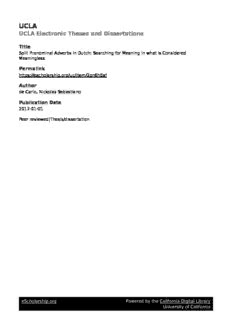
Split Pronominal Adverbs in Dutch: Searching for Meaning in what is Considered Meaningless PDF
Preview Split Pronominal Adverbs in Dutch: Searching for Meaning in what is Considered Meaningless
UCLA UCLA Electronic Theses and Dissertations Title Split Pronominal Adverbs in Dutch: Searching for Meaning in what is Considered Meaningless Permalink https://escholarship.org/uc/item/2qn6h0xf Author de Carlo, Nickolas Sebastiano Publication Date 2017 Peer reviewed|Thesis/dissertation eScholarship.org Powered by the California Digital Library University of California UNIVERSITY OF CALIFORNIA Los Angeles Split Pronominal Adverbs in Dutch: Searching for Meaning in what is Considered Meaningless A dissertation submitted in partial satisfaction of the requirements for the degree Doctor of Philosophy in Germanic Languages by Nickolas Sebastiano de Carlo 2017 © Copyright by Nickolas Sebastiano de Carlo 2017 ABSTRACT OF THE DISSERTATION Split Pronominals in Dutch: Searching for Meaning in what is Considered Meaningless by Nickolas Sebastiano de Carlo Doctor of Philosophy in Germanic Languages University of California, Los Angeles, 2017 Professor Robert S. Kirsner, Chair Pure synonymy is a myth. This is true in the lexicon of a language as well as its grammar. As such, why do grammars of Dutch label the following two forms below as synonymous? Unsplit: Daarmee heb ik een probleem. Therewith have I a problem. Split: Daar heb ik een probleem mee. There have I a problem with. "I have a problem with that." Calling these two forms above "the same" is an oversimplification. In my dissertation, Itest for difference in meaning between the forms and the motivation to choose one form over the other. To accomplish this goal, Iuse a corpus-based approach integrated with tests from Construction Grammar. We analyze these data in R (a statistics computing language) and Excel. This dissertation includes four tests, all complete. Preliminary findings underline a difference in meaning and provide motivation for the two forms. This is significant, as the current state of ii research suggests no real difference or meaning. Only one study, Honselaar (1994), discusses any possible variation in meaning. Additionally, emerging studies in linguistics frequently utilize larger data sets. This dissertation supports the shift toward more quantifiable data coupled with trained qualitative analysis. The quantifiable tests show a meaning difference, questioning the traditional analysis. Unsplit forms exhibit a shift in discourse, and split show continuation thereof. Regarding motivation for the two forms, the data show clauses with verbs of low use frequency tend to be unsplit, suggesting that higher frequency verbs are more likely to occur with split forms. Frequency tends to be understood and decoded quicker (Fenk-Oczlon, 2001), and thus the listener/reader is generally able to parse the second half of the pronominal adverb, namely the preposition, before its utterance. This suggests that it would be easier to continue forward in the discourse if the form is split. These findings underline the growing need for further development of corpus-based linguistics studies. They welcome the movement of linguistics toward more empirical approaches to language. iii This dissertation of Nickolas Sebastiano de Carlo is approved. Christopher M. Stevens Hongyin Tao Robert S. Kirsner, Committee Chair University of California, Los Angeles 2017 iv منازیزا v Table of Contents 1 Problem .................................................................................................................................... 1 1.1 Object of Inquiry .............................................................................................................. 4 1.2 Function of Pronominal Adverbs ..................................................................................... 6 1.3 Choice of Pronominal Adverb: Daarmee ......................................................................... 7 1.4 Met ................................................................................................................................... 8 1.5 Daar .................................................................................................................................. 9 1.6 Summary of Study .......................................................................................................... 11 2 Construction Grammar .......................................................................................................... 12 3 Source Material (Corpus discussion) ..................................................................................... 15 4 Introduction to the Tests ........................................................................................................ 18 4.1 Previous Studies into Split Pronominal Adverbs ........................................................... 19 5 Test One: Phrasal Verbs ........................................................................................................ 26 5.1 Introduction .................................................................................................................... 26 5.2 Problem .......................................................................................................................... 28 5.3 Methodology .................................................................................................................. 29 5.4 Collostructional Analysis ............................................................................................... 32 5.5 Results ............................................................................................................................ 34 5.6 Individual Verbs ............................................................................................................. 36 5.7 Closing Discussion ......................................................................................................... 38 6 Test Two: Frequency ............................................................................................................. 42 6.1 Introduction .................................................................................................................... 42 vi 6.2 Methodology .................................................................................................................. 44 6.3 Genres/Lists .................................................................................................................... 45 6.4 Correlation ...................................................................................................................... 49 6.5 Conclusion Test Two ..................................................................................................... 55 7 Test Three: WordNet & Transitivity ..................................................................................... 57 7.1 Methodology .................................................................................................................. 58 7.2 Data Preparation ............................................................................................................. 60 7.3 Results ............................................................................................................................ 61 7.4 Transitivity ..................................................................................................................... 67 7.5 Meaning Difference........................................................................................................ 73 8 Test Four: Literature & Semantic Integrality ........................................................................ 77 8.1 Methodology .................................................................................................................. 78 8.2 Implementation of Test Three on the Novels ................................................................. 81 8.3 Semantic Integrality ....................................................................................................... 83 8.4 Extracts ........................................................................................................................... 86 8.5 De donkere kamer van Damocles................................................................................... 87 8.6 Nooit meer slapen......................................................................................................... 101 8.7 Review .......................................................................................................................... 114 9 Conclusion ........................................................................................................................... 117 10 Appendix A: Tree Tagger Numerical Values .................................................................. 121 11 Appendix B: Met Verbs ................................................................................................... 123 12 Appendix C: Prepositions from Zwarts (1997) ................................................................ 127 vii 13 Appendix D: Sources of the 38 Million Word Corpus .................................................... 130 14 Bibliography .................................................................................................................... 134 viii
